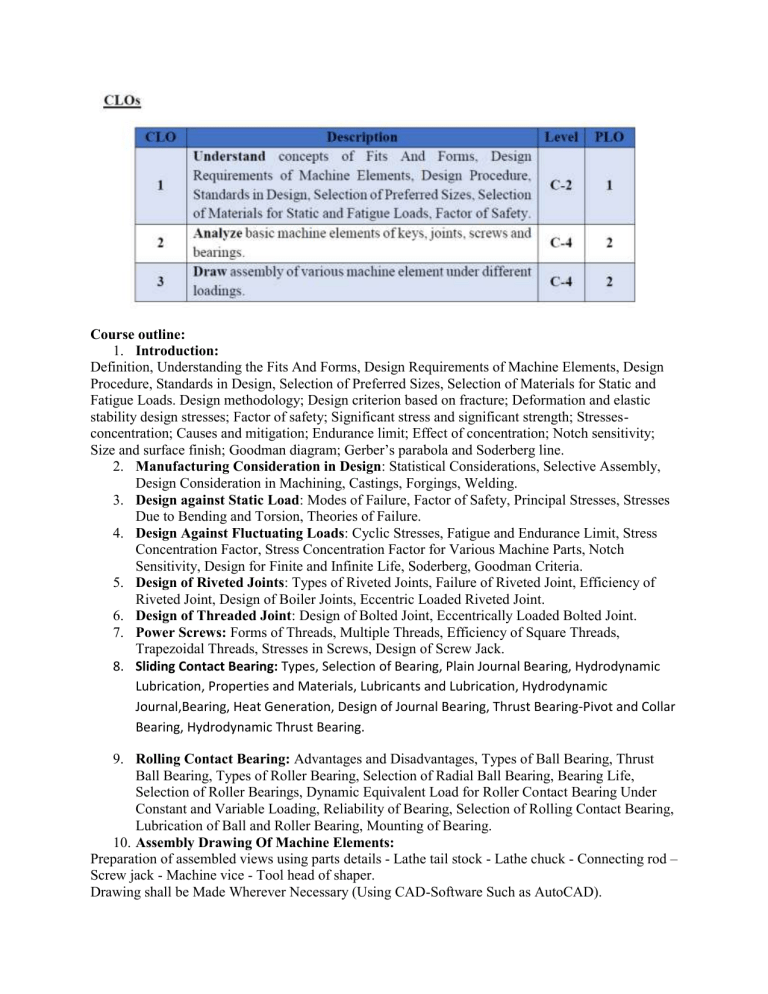
Course outline: 1. Introduction: Definition, Understanding the Fits And Forms, Design Requirements of Machine Elements, Design Procedure, Standards in Design, Selection of Preferred Sizes, Selection of Materials for Static and Fatigue Loads. Design methodology; Design criterion based on fracture; Deformation and elastic stability design stresses; Factor of safety; Significant stress and significant strength; Stressesconcentration; Causes and mitigation; Endurance limit; Effect of concentration; Notch sensitivity; Size and surface finish; Goodman diagram; Gerber’s parabola and Soderberg line. 2. Manufacturing Consideration in Design: Statistical Considerations, Selective Assembly, Design Consideration in Machining, Castings, Forgings, Welding. 3. Design against Static Load: Modes of Failure, Factor of Safety, Principal Stresses, Stresses Due to Bending and Torsion, Theories of Failure. 4. Design Against Fluctuating Loads: Cyclic Stresses, Fatigue and Endurance Limit, Stress Concentration Factor, Stress Concentration Factor for Various Machine Parts, Notch Sensitivity, Design for Finite and Infinite Life, Soderberg, Goodman Criteria. 5. Design of Riveted Joints: Types of Riveted Joints, Failure of Riveted Joint, Efficiency of Riveted Joint, Design of Boiler Joints, Eccentric Loaded Riveted Joint. 6. Design of Threaded Joint: Design of Bolted Joint, Eccentrically Loaded Bolted Joint. 7. Power Screws: Forms of Threads, Multiple Threads, Efficiency of Square Threads, Trapezoidal Threads, Stresses in Screws, Design of Screw Jack. 8. Sliding Contact Bearing: Types, Selection of Bearing, Plain Journal Bearing, Hydrodynamic Lubrication, Properties and Materials, Lubricants and Lubrication, Hydrodynamic Journal,Bearing, Heat Generation, Design of Journal Bearing, Thrust Bearing-Pivot and Collar Bearing, Hydrodynamic Thrust Bearing. 9. Rolling Contact Bearing: Advantages and Disadvantages, Types of Ball Bearing, Thrust Ball Bearing, Types of Roller Bearing, Selection of Radial Ball Bearing, Bearing Life, Selection of Roller Bearings, Dynamic Equivalent Load for Roller Contact Bearing Under Constant and Variable Loading, Reliability of Bearing, Selection of Rolling Contact Bearing, Lubrication of Ball and Roller Bearing, Mounting of Bearing. 10. Assembly Drawing Of Machine Elements: Preparation of assembled views using parts details - Lathe tail stock - Lathe chuck - Connecting rod – Screw jack - Machine vice - Tool head of shaper. Drawing shall be Made Wherever Necessary (Using CAD-Software Such as AutoCAD). 1. To Draw Orthographic projection Drawings (Front, Top and side) of boiler safety valve giving name the various components of the valve. 2. Make an Isometric dimensioned drawing of a connecting Rod using isometric grid and snap. Draw quarter sectional isometric view of a cotter joint 3. Design & Drawing of Knuckle Joint. 4. Design of Machine Components Subjected to Combined Steady and Variable Loads. 5. Design & Drawing of Eccentrically Loaded Riveted Joint. 6. Design & Drawing of Boiler Riveted Joint. 7. Design of Shaft Subjected to Fluctuating Loads. 8. Design of Screw Jack. 9. Design of Eccentrically Loaded Threaded Joint. 10. Design of Antifriction Bearing Assembly 11. Design of Journal Bearing 12. Design of Project Report Consists of Different Types of Bearings 13. Design of Cylinder and Cylinder Head. 14. Design of Piston, Piston Ring and Gudgeon Pin. 15. Design of Connecting Rod. 16. Design of Crankshafts. Recommended Books: 1. Shigely Joseph E., “Mechanical Engineering Design”, McGraw-Hill Publications. (Latest Edition) 2. Valance Alex and Doughtie VI, “Design of Machine Members”, McGraw-Hill Co. (Latest Edition) 3. Spott M.F., “Machine design”, Prentice Hall India. (Latest Edition) 4. Maleev and Hartman, “Machine Design”, CBS Publications. (Latest Edition) 5. Black & Adams, “Machine design”, McGraw-Hill. (Latest Edition) 6. Sharma and Agrawal, “Machine Design”, S.K. Katara& Sons. 7. Bhandari V.B., “Design of Machine Elements”, Tata McGraw-



